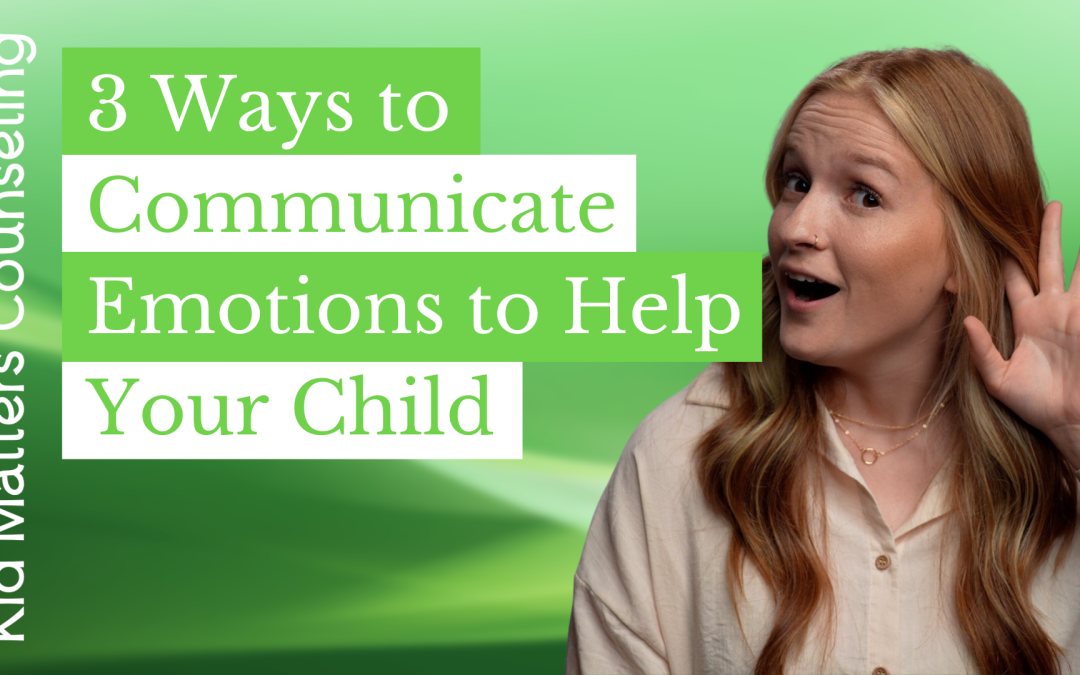Communication of emotions between parents and children can help develop emotional intelligence, improve relationships, and increase resilience in the face of challenges. The problem is, parents struggle to do this well and children are often left feeling anxious and can negatively impact the parent-child relationship.
I’m Lizzie Doppler, a child therapist at Kid Matters Counseling, and I’m here to help you learn three ways to communicate emotions that will actually help your child.
Share Your Emotions
First, it’s important to remember that it’s okay for your child to see you healthily share your emotions. When you share your emotions with them, you show them that it’s okay to feel and express their own emotions.
This helps them develop a positive self-image and teaches them how to communicate their feelings in a healthy way.
For example, if you’re feeling sad, instead of hiding it from your child, you could say something like, “I’m feeling a little sad today, but that’s okay. Sometimes we all feel sad and it’s important to talk about it.”
This shows your child that it’s normal to feel sad sometimes and that it’s okay to talk about it. It also models healthy emotional expression and helps your child feel more comfortable expressing their own emotions.
Validate Your Child’s Emotions
Second, validate your child’s emotions. When your child expresses their feelings, let them know that it’s okay to feel that way. This helps them feel heard and understood, which can go a long way in building a strong relationship with them.
If your child is feeling sad because they lost a game, you might say something like, “I can see that you’re feeling really disappointed right now. It’s okay to feel sad when things don’t go the way we want them to.”
This shows your child that you understand how they’re feeling and that it’s okay to have those feelings. It also helps them feel heard and validated, which can strengthen your emotional connection with them.
Use Open-Ended Questions
Finally, use open-ended questions to encourage your child to talk about their emotions. Instead of asking yes or no questions, ask questions that encourage them to share their thoughts and feelings.
This helps them feel more comfortable opening up to you and can lead to deeper, more meaningful conversations.
Instead of asking, “Did you have a good day at school?” which can be answered with a simple “yes” or “no,” try asking, “What was the best part of your day today?” This encourages your child to share more information and express their thoughts and feelings in a deeper way.
By following these three simple steps, you can help your child feel heard, understood, and valued.
If you’re still struggling to connect with your child, don’t hesitate to schedule an appointment today. We’re here to help you and your family every step of the way.

Lizzie Doppler
Child Therapist
By taking a strength-based approach, I empower children to work through their big emotions in a positive way.
New Clients Call: (855) 586-1802
Current Clients: (855) 543-7687
Ask Us Anything!
We help anxious kids and frustrated parents. We serve Hinsdale & the Western Suburbs of Chicago.
Made with ♥︎ in Hinsdale, Illinois for Chicago
Built By Brand Your Practice.
Kid Matters Counseling, P.C. DISCLAIMER: This website and blog are for informational, educational and general discussion purposes only. It is understood that no guarantee or warranty arises from the information provided, discussed or commented upon in this website and blog nor does it constitute legal or other professional advice on any subject matter. Access to this website and blog is voluntary and at the sole risk of the user. If you think that you have a medical emergency (including clinical), call your doctor or 911 immediately. A licensed medical professional should be consulted for diagnosis and treatment of any and all medical conditions. While the information contained within this website and blog is periodically updated, no guarantee is given that the information provided is correct, complete, and/or up-to-date. See our complete Privacy Policy and Terms of Service.





